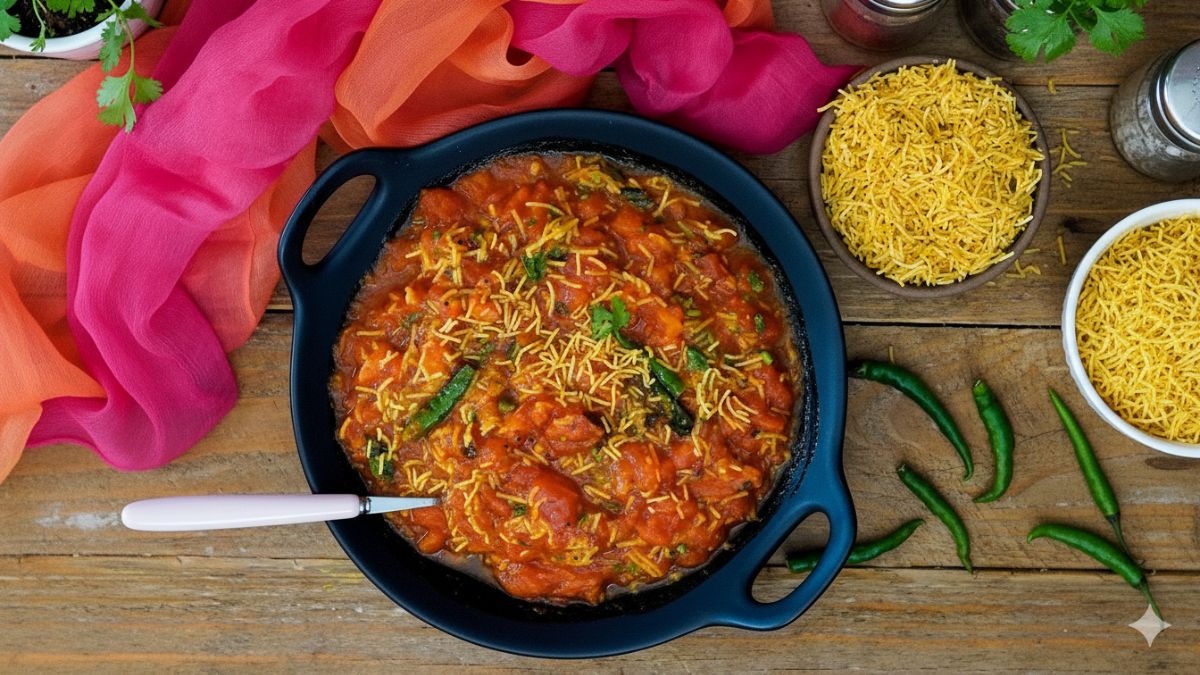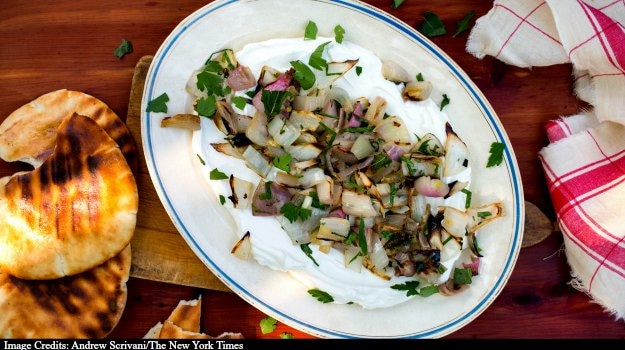In my backyard, summer grilling is hot, fast and furious. My aim is to cook dinner quickly so that I can close the grill and eliminate one of the heat sources in my already stifling garden.Autumn grilling can be a more leisurely affair. This is the time of year when evenings are cool enough to warrant leaving the grill on, both for slow cooking and to warm me up.Slow cooking (that is, using indirect heat) is good for thick and dense ingredients that may benefit from being left alone on a not-too-hot grill for a while. It basically turns your grill into a giant outdoor oven, with the added benefit of smoke if you’re using hardwood charcoal as fuel.
I like to use indirect heat for some bone-in meats (steaks, chops, ribs and chicken) and for an array of vegetables, in this case shallots, onions and garlic.When thinly sliced and placed directly over the flames, the alliums brown quickly.But when cut into larger chunks and positioned next to, rather than over, the fire, they turn sweet, soft and charred at the edges. Some bits will be meltingly tender, some bits slightly more firm and juicy, and the contrast is delightful.The key here is to move the vegetables around as needed. If they aren’t picking up enough color on the cooler side of the grill, move them to the hotter part for a few minutes. Use your judgment here, because you know your grill best.Once the vegetables are brown-edged and tender-bodied, let them cool until you can bear to touch them, then chop them into a relish seasoned with preserved lemon and fresh herbs.I like to use the relish as a topping for labneh, a thick and creamy Middle Eastern yogurt. But Greek yogurt works nearly as well. Or spoon the relish onto hummus (store-bought is OK) for something dairy-free. The relish is also nice served with grilled fish, meats or chicken, which you can cook at the same time.All this said, if you’ve already packed up your grill (either mentally or physically), or if you don’t have one (or a backyard for that matter), make this in the oven. You won’t get the same smoky flavor as if you had used hardwood charcoal, but you’ll still get the sweetness and the char.<a href="https://cooking.nytimes.com/recipes/1017717-charred-shallots-with-labneh-and-pita" rel="nofollow"></a><a href="https://cooking.nytimes.com/topics/summer-barbecue" rel="nofollow"></a>Charred Shallots With Labneh and Pita4 medium shallots1 medium white onion5 garlic cloves, peeled and left whole5 tablespoons extra-virgin olive oil, more as needed2 tablespoons chopped parsley, plus a handful of whole leaves1 tablespoon chopped mint, plus a handful of whole leaves1 tablespoon finely chopped preserved lemon1 teaspoon lemon juiceKosher salt, as neededBlack pepper, as needed2 cups labneh or full-fat Greek yogurtSumac, as neededGrilled pita, for serving1. Peel shallots and halve lengthwise through root end. Peel onion and cut into 2-inch chunks. Thread shallots and onion chunks onto metal or pre-soaked bamboo skewers. Thread garlic cloves onto a separate skewer. (If you’re using the oven, skip this step and see note below on how to prepare the vegetables.)2. Light or heat one side of the grill. Leave the other side bare for indirect grilling (if using a charcoal grill, mound coals to one side of the grill). Lightly brush skewers with 1 tablespoon of the olive oil and place over the bare side of the grill for indirect heat. Cover and cook, turning occasionally, until the garlic is soft, 30 to 35 minutes.3. When the garlic is soft, remove from grill or oven. Transfer onion and shallot to the hottest part of the grill (add more coals if necessary) and continue cooking, turning occasionally, until onions are almost tender and well charred in spots, 15 to 20 minutes more.4. When cool enough to handle, coarsely chop onion and shallot and place in a large bowl. Mash garlic and add to bowl. Toss in remaining 4 tablespoons oil, the chopped parsley and mint, the preserved lemon, the lemon juice and the salt and pepper. Taste and add more salt, olive oil and/or lemon juice as needed. This mixture should be highly seasoned.5. Spread labneh or yogurt on a large platter. Spoon onion mixture over surface. Drizzle with additional oil, and tear mint and parsley leaves and scatter over top. Sprinkle with sumac. Serve with grilled pita.TipIf you’re using the oven instead of the grill, place the onions, shallots and garlic on a rimmed baking sheet, keeping the different vegetables in distinct groups, and making sure there is plenty of space between the pieces so they can brown. Roast at 450 degrees until charred all over, 15 to 35 minutes depending on the vegetable. Remove vegetables as they brown. The garlic will probably be ready first, followed by the shallots and finally the onion. Proceed with the recipe starting at Step 4.© 2015 The New York Times News Service
I like to use indirect heat for some bone-in meats (steaks, chops, ribs and chicken) and for an array of vegetables, in this case shallots, onions and garlic.When thinly sliced and placed directly over the flames, the alliums brown quickly.But when cut into larger chunks and positioned next to, rather than over, the fire, they turn sweet, soft and charred at the edges. Some bits will be meltingly tender, some bits slightly more firm and juicy, and the contrast is delightful.The key here is to move the vegetables around as needed. If they aren’t picking up enough color on the cooler side of the grill, move them to the hotter part for a few minutes. Use your judgment here, because you know your grill best.Once the vegetables are brown-edged and tender-bodied, let them cool until you can bear to touch them, then chop them into a relish seasoned with preserved lemon and fresh herbs.I like to use the relish as a topping for labneh, a thick and creamy Middle Eastern yogurt. But Greek yogurt works nearly as well. Or spoon the relish onto hummus (store-bought is OK) for something dairy-free. The relish is also nice served with grilled fish, meats or chicken, which you can cook at the same time.All this said, if you’ve already packed up your grill (either mentally or physically), or if you don’t have one (or a backyard for that matter), make this in the oven. You won’t get the same smoky flavor as if you had used hardwood charcoal, but you’ll still get the sweetness and the char.<a href="https://cooking.nytimes.com/recipes/1017717-charred-shallots-with-labneh-and-pita" rel="nofollow"></a><a href="https://cooking.nytimes.com/topics/summer-barbecue" rel="nofollow"></a>Charred Shallots With Labneh and Pita4 medium shallots1 medium white onion5 garlic cloves, peeled and left whole5 tablespoons extra-virgin olive oil, more as needed2 tablespoons chopped parsley, plus a handful of whole leaves1 tablespoon chopped mint, plus a handful of whole leaves1 tablespoon finely chopped preserved lemon1 teaspoon lemon juiceKosher salt, as neededBlack pepper, as needed2 cups labneh or full-fat Greek yogurtSumac, as neededGrilled pita, for serving1. Peel shallots and halve lengthwise through root end. Peel onion and cut into 2-inch chunks. Thread shallots and onion chunks onto metal or pre-soaked bamboo skewers. Thread garlic cloves onto a separate skewer. (If you’re using the oven, skip this step and see note below on how to prepare the vegetables.)2. Light or heat one side of the grill. Leave the other side bare for indirect grilling (if using a charcoal grill, mound coals to one side of the grill). Lightly brush skewers with 1 tablespoon of the olive oil and place over the bare side of the grill for indirect heat. Cover and cook, turning occasionally, until the garlic is soft, 30 to 35 minutes.3. When the garlic is soft, remove from grill or oven. Transfer onion and shallot to the hottest part of the grill (add more coals if necessary) and continue cooking, turning occasionally, until onions are almost tender and well charred in spots, 15 to 20 minutes more.4. When cool enough to handle, coarsely chop onion and shallot and place in a large bowl. Mash garlic and add to bowl. Toss in remaining 4 tablespoons oil, the chopped parsley and mint, the preserved lemon, the lemon juice and the salt and pepper. Taste and add more salt, olive oil and/or lemon juice as needed. This mixture should be highly seasoned.5. Spread labneh or yogurt on a large platter. Spoon onion mixture over surface. Drizzle with additional oil, and tear mint and parsley leaves and scatter over top. Sprinkle with sumac. Serve with grilled pita.TipIf you’re using the oven instead of the grill, place the onions, shallots and garlic on a rimmed baking sheet, keeping the different vegetables in distinct groups, and making sure there is plenty of space between the pieces so they can brown. Roast at 450 degrees until charred all over, 15 to 35 minutes depending on the vegetable. Remove vegetables as they brown. The garlic will probably be ready first, followed by the shallots and finally the onion. Proceed with the recipe starting at Step 4.© 2015 The New York Times News Service
Advertisement







